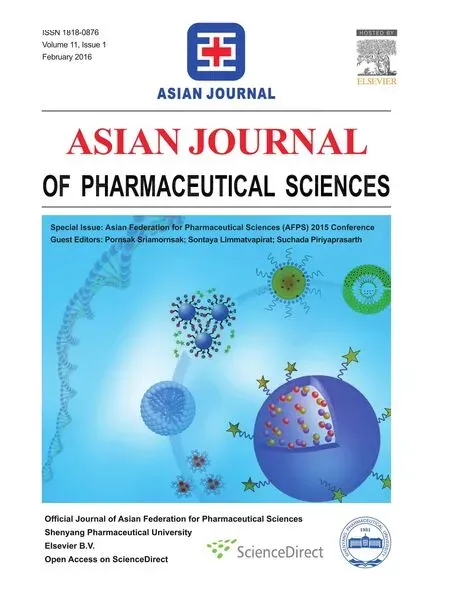Development of nanocrystal formulation of mebendazole with improved dissolution and pharmacokinetic behaviors
Setsunan University,45-1 Nagaotoge-cho,Hirakata,Osaka 573-0101,Japan
Development of nanocrystal formulation of mebendazole with improved dissolution and pharmacokinetic behaviors
Naofumi Hashimoto*,Kayo Yuminoki,Haruka Takeuchi,Chiaki Okada
Setsunan University,45-1 Nagaotoge-cho,Hirakata,Osaka 573-0101,Japan
A R T I C L E I N F O
Article history:
Available online 25 November 2015
Mebendazole
Nanocrystal
Wet beads milling
Oral absorption
Nanosizing by wet beads milling is a method to improve the solubility of poorly water soluble compounds[1,2].Mebendazole (MBZ)is a well-known anthelmintic drug in wide clinical use. There were some reports that MBZ had the anticancer effect in preclinical study.However,the bioavailability of MEB is low (<10%)due to the poor solubility in water(0.5 μg/mL).The present study aimed to develop the nanocrystal formulations of MEB to improve dissolution behavior and enhance oral absorption.
The MBZ nano-suspension was prepared by milling with zirconia beads(milling media)in polymer aqueous solution (dispersion stabilizer)by the rotation/revolution pulverizer[3]. Then,milled MBZ powder was prepared by freeze-drying the MEB nano-suspension.Four polymers(polyvinyl alcohol(PVA), hydroxypropylcellulose-SSL(HPC),methylcellulose(MC),and copolymer of PVA,acrylic acid and methyl methacrylate(POVA)) were used to evaluate the dispersion stabilities of the MBZ nanosuspension and the re-dispersion stability of the milled MBZ powder.Dispersion stability,re-dispersion stability,and crystallinity of the MBZ nano-suspensions and the milled MBZ powders were evaluated by particle size analyzer and powder X-ray diffraction(PXRD),respectively.In addition,the dissolution behavior and the oral absorption of the milled MBZ powder were evaluated.The MBZ nano-suspensions with PVA and HPC had better dispersion stability[the diameters at 90% of the population distribution(D90)=ca.0.210 μm]than the MBZ nano-suspensions with MC and POVA(D90>1 μm).The milled powder with PVA showed the good re-dispersion stability when the mass ratio of PVA to MEB was more than three(Fig.1a). On the other hand,fve of the mass ratio of HPC to MEB was necessary to re-disperse the milled MBZ powder in water.Therefore,the milled MBZ powder with PVA(MBZ:PVA=1:3)was used to evaluate the crystallinity,the dissolution behavior and the oral absorption.The PXRD patterns of the milled MBZ were similar to that of the original MBZ,which showed that the milled MBZ maintained its crystallinity.In comparison of theoriginal MBZ with the milled MBZ powder,the dissolution behavior of MBZ in aqueous solutions adjusted pH 1.2 and pH 6.8 were improved by milling to nanoparticles.After oral administration of the milled MBZ powder(10 mg MBZ/kg)in rats, the enhanced oral absorption of MBZ was observed with increases of Cmaxand AUC0–8by 4-and 3-fold,respectively,compared with those of the original MBZ(Fig.1b).The nanosizing approach was effective to enhance the bioavailability of MBZ. From the improvement of oral absorption,the nano-sized MBZ could increase the probability of application for the cancer treatment.

Fig.1–Particles size distribution of the original MBZ(black line)and the milled MBZ with PVA(red line)(a)and plasma concentrations of MBZ after oral administration of the original MBZ(▲)and the milled MBZ(◆)with PVA to rats(b).
R E F E R E N C E S
[1]Filippos K,Santipharp P,Yunhui W.Nanosizing–oral formulation development and biopharmaceutical evaluation. Adv Drug Deliv Rev 2007;59:631–644.
[2]Kipp JE.The role of solid nanoparticles technology in the parenteral delivery of poorly water soluble drugs.Int J Pharm 2004;284:109–122.
[3]Takatsuka T,Endo T,Jianguo Y,et al.Nanosizing of poorly water soluble compounds using rotation/revolution mixer. Chem Pharm Bull 2009;57:1061–1067.
*E-mail address:hashimoto@pharm.setsunan.ac.jp.
Peer review under responsibility of Shenyang Pharmaceutical University.
http://dx.doi.org/10.1016/j.ajps.2015.11.096
1818-0876/?2016 Production and hosting by Elsevier B.V.on behalf of Shenyang Pharmaceutical University.This is an open access article under the CC BY-NC-ND license(http://creativecommons.org/licenses/by-nc-nd/4.0/).
 Asian Journal of Pharmacentical Sciences2016年1期
Asian Journal of Pharmacentical Sciences2016年1期
- Asian Journal of Pharmacentical Sciences的其它文章
- Determination of the antidepressant effect of mirtazapine augmented with caffeine using Swiss-albino mice
- Photosafety testing of dermally-applied chemicals based on photochemical and cassette-dosing pharmacokinetic data
- Biopharmaceutics classifcation system(BCS)-based biowaiver for immediate release solid oral dosage forms of moxifoxacin hydrochloride (Moxifox GPO)manufactured by the Government Pharmaceutical Organization(GPO)
- Bioequivalence study of abacavir/lamivudine (600/300-mg)tablets in healthy Thai volunteers under fasting conditions
- Evaluation of cytotoxic and infammatory properties of clove oil microemulsion in mice
- Analytical method development of pregabalin and related substances in extended release tablets containing polyethylene oxide
